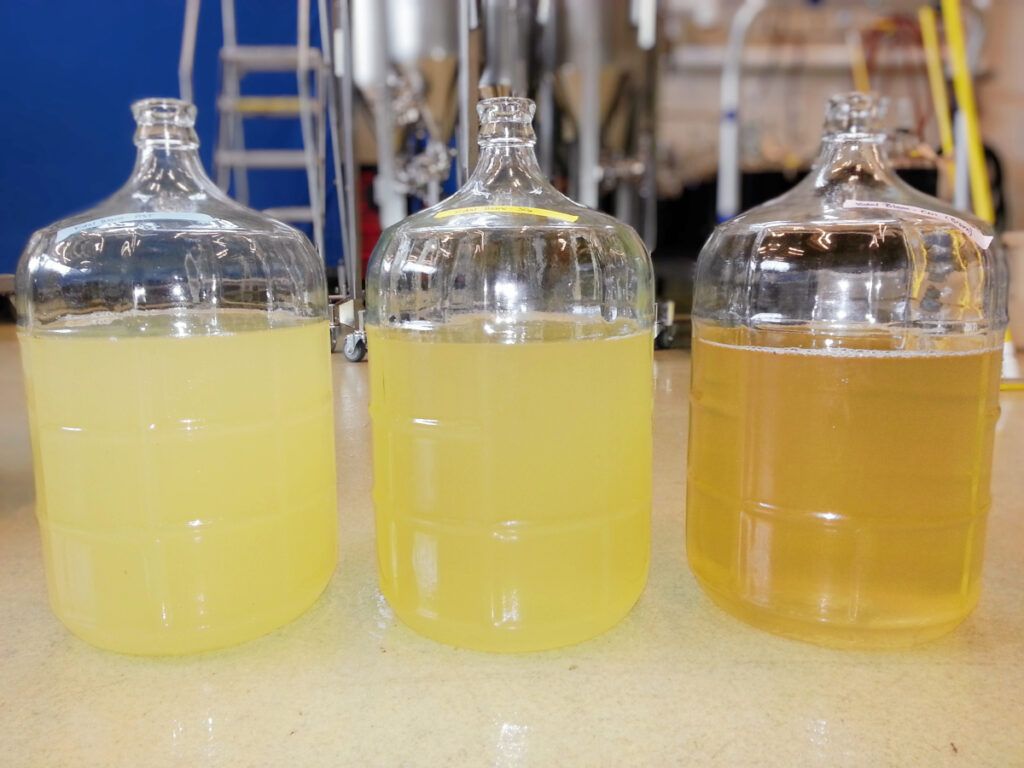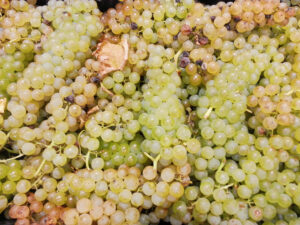
Photo by: Denise M. Gardner
In the pre-fermentation juice stages of white wine production, winemakers are provided the option to add sulfur dioxide (or not).
Do you know why you would (or wouldn’t) add sulfur dioxide to a white juice pre-fermentation?
When sulfur dioxide is added to most white juice, the browning enzyme polyphenol oxidase or PPO is inactivated. The inactivation of the PPO enzyme restores the yellow-to-green color of the juice. The act of adding sulfur dioxide to white juice prior to fermentation is often referred to as “green juice” fermentations.
In comparison, a small sulfur dioxide addition or the lack of adding sulfur dioxide, allows the PPO enzyme to work naturally, giving rise to a brown juice color. This process is often referred to as “brown juice” fermentations.
However, in addition to these noticeable visual changes, the act of adding sulfur dioxide to the juice will also influence the final wine sensory for many white wine grape varieties. Let’s read on to discover a little more on what’s going on when a winemaker decides whether to add sulfur dioxide prior to the start of a white wine fermentation.
Brown Juice Sensory Effects
When a white juice is allowed to brown, not only is PPO activated and browning, several other oxidative reactions are taking place. Many tannins are also oxidized. Furthermore, aroma and flavor compounds also go through an oxidation phase or are altered.
Due to these additional chemical processes, the use of brown juice fermentation is often recommended for neutral white wine grape varieties or those white wine grape varieties that tend to carry excessive perceptible astringency into the wine.
Why?
If flavor compounds are oxidized pre-fermentation, the intensity of aromatics can get diminished in the final wine. Therefore, many aromatic white wine varieties are often treated with sulfur dioxide prior to fermentation to preserve all those precious aroma compounds affiliated with the varietal character.
However, the benefit of softening the wine through this pre-fermentation oxidation may be preferred for some white wine varieties.
Green Juice Sensory Effects
While the addition of sulfur dioxide may help preserve aromatics, it also helps preserve tannin by inhibiting tannin oxidation that would otherwise soften those harsher, astringent tannins. Have you ever had a white wine that seemed relatively astringent? It’s likely that the winemaker opted for a relatively strong sulfur dioxide addition prior to the start of fermentation.
How to Choose a Green Juice or Brown Juice Strategy

Photo by: Denise M. Gardner
For winemakers that use flotation for clarification of white juice prior to fermentation, the juice is likely getting some form of brown juice processing. Flotation tends to lean “oxidative” in terms of providing oxygen to the juice. However, there are strategies, including the use of inert gas instead of pulsed air, to reduce the amount of oxygen that gets dissolved into the juice prior to fermentation.
For those winemakers that choose enzymatic settling of their juice, there’s more flexibility in choosing between a brown juice and a green juice process. This provides the winemaker with some control in choosing a desired sensory outcome for their final wine. However, I would also encourage winemakers to consider spoilage risk associated with the juice as juice with a higher spoilage risk, or juice left at warmer temperatures, is typically encouraged to contain some sulfur dioxide.
Regardless of which strategy a winemaker chooses, the brown color will not carry over into the wine. Through fermentation, these browned pigments fall and settle out with the lees.
For winemakers that would like the benefit of softening tannins while retaining aromatic complexity, products that contain a mixture of ascorbic acid, tannin, and sulfur dioxide are encouraged. These products typically generate a more austere and complex aromatic profile for the white wine. They emulate a more “reductive” processing version for that variety. Two products that I have used in the past include AST by Enartis and Suprarom by Laffort.
You’ll also see these products recommended for fruit infected with significant levels of Botrytis. This is because these products are a blend of antioxidants, inhibiting oxidative processes.
Always make sure you use these products according to the supplier’s directions. As both products contain sulfur dioxide, a portion will get directed into the free form. When juice pH’s are low, high doses of these combination products can potentially inhibit fermentation (or may require a very aggressive yeast strain). Thus, winemakers have to be mindful about dosage rates.
Nonetheless, having the option to manipulate wine aroma and astringency is something of consideration for many winemakers. The manipulation can have direct impact on wine style and offers a great benefit for wine quality.
A Final Note
While I’ve played around with these strategies in different white wine varieties, I have not yet experienced a noticeable change in astringency perception for many white hybrid varieties. In general, I tend to find many white hybrid varieties softer in their mouthfeel compared to Vitis vinifera white variety wines. Thus, for me, a brown juice strategy is not something I regularly recommend for many hybrid white wine fermentations.
The views and opinions expressed through dgwinemaking.com are intended for general informational purposes only. Denise Gardner Winemaking does not assume any responsibility or liability for those winery, cidery, or alcohol-producing operations that choose to use any of the information seen here or within dgwinemaking.com.
